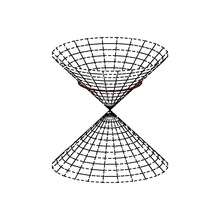Null vector

In mathematics, given a vector space X with an associated quadratic form q, written (X, q), a null vector or isotropic vector is a non-zero element x of X for which q(x) = 0.
In the theory of real bilinear forms, definite quadratic forms and isotropic quadratic forms are distinct. They are distinguished in that only for the latter there exists a nonzero null vector. Where such a vector exists, (X, q) is called a pseudo-Euclidean space.
A pseudo-Euclidean vector space may be decomposed (non-uniquely) into orthogonal subspaces A and B, X = A + B, where q is positive-definite on A and negative-definite on B. The null cone, or isotropic cone, of X consists of the union of balanced spheres:
The null cone is also the union of the isotropic lines through the origin.
Examples
The light-like vectors of Minkowski space are null vectors.
The four linearly independent biquaternions l = 1 + hi, n = 1 + hj, m = 1 + hk, and m∗ = 1 – hk are null vectors and { l, n, m, m∗ } can serve as a basis for the subspace used to represent spacetime. Null vectors are also used in the Newman–Penrose formalism approach to spacetime manifolds.[1]
A composition algebra splits when it has a null vector; otherwise it is a division algebra.
In the Verma module of a Lie algebra there are null vectors.
References
- ↑ Patrick Dolan (1968) A Singularity-free solution of the Maxwell-Einstein Equations, Communications in Mathematical Physics 9(2):161–8, especially 166, link from Project Euclid
- Dubrovin, B. A.; Fomenko, A. T.; Novikov, S. P. (1984). Modern Geometry: Methods and Applications. Translated by Burns, Robert G. Springer. p. 50. ISBN 0-387-90872-2.
- Shaw, Ronald (1982). Linear Algebra and Group Representations. 1. Academic Press. p. 151. ISBN 0-12-639201-3.
- Neville, E. H. (Eric Harold) (1922). Prolegomena to Analytical Geometry in Anisotropic Euclidean Space of Three Dimensions. Cambridge University Press. p. 204.